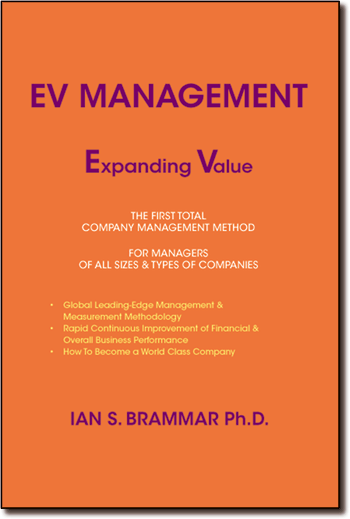The only solutions proposed for retaining a substantial healthy manufacturing/industry base in Australia tend to be based on increasing tariff protection and imposing quotas on imported goods and services. However these solutions are unlikely to happen or even if they do to be short term.
There are only two major solutions for individual companies in the short, medium and long term and that is to have better products and services than competitors and to be able to be more productive, hence more competitive in the production of those goods and services. Therefore the fundamental question is “are the latter two solutions possible particularly in view of lower cost labour for companies in countries such as India and China”. The answer for at least the foreseeable future is now a resounding yes!
The use of modern advanced measurement of a considerable number of companies in Australia has revealed two startling results. The first is that over 95% of Australian Industrial companies have locked into their day to day operations over 25% additional productivity potential, which cannot be released at present. In fact, for a considerable proportion of that 95% the locked in productivities are over 30%.
These operations include everything from product development through manufacturing, finance, marketing and sales. This is the situation even after over two decades of the application of such methods as Just-in-time, Lean Management, Six Sigma and so on. All of these latter types of methods have been heavily promoted by consultants and organisations and have had an impact on increasing quality and delivery performance, but often with only marginal effect on overall competitiveness and financial and business performance.
The methods have not been able to access and release the intractable locked-in productivities. If they had been able to, the effects would have been as dramatic as a 5% increase in productivity, using no extra capital input, raising operating profit by over 100% for a company. A rise of 25% can increase profit by over 1,000%! In most cases this would be more than enough to offset competition from low labour cost companies overseas for several years ahead.
So what is the second startling thing revealed by advanced measures? It is the reason for the locked in inaccessible productivities. The reason is that most companies in Australia (over 99%) are still using a mix of the three old-fashioned overall (“top-downing”) management systems, which I shall call Conventional Management.
The so called World Class companies (Toyota is probably one of these) have internally learnt how to change their “top-down” management system to bring them to the stage where they can take maximum financial and overall business performance advantage from the new powerful “bottom upping methods", such as Just-in-time, mistake proofing etc.. Not only that, they can determine with considerable confidence what are the priorities for development, so as to obtain the most rapid improvement in bottom line performance in the shortest time at the lowest cost.
Some of the major missing items (from “top-down”, modern management methods) in Conventional Management are:
1. The ability and methodology to directly connect conventional financial measures and their targets for improvement to day-to-day operational measures and forward planning financial targets.
2. A complete, pragmatic, strategic, tactical and measurement framework for directing continuous overall business and financial improvements in any type or size of company.
3. The ability to prioritise company developments in an accurate measured way to achieve the most rapid rate of improvement in competitiveness and financial performance.
4. The capability of maximising employee input and creativity within a carefully measured and controlled environment (also of being able to accurately measure this input)
5. The ability to switch from subjective decision making to objective, measured decision making at all management levels.
6. A universally applicable simple thinking and action framework for any manager at any level.
7. The knowledge and methods to release the imbedded additional productivity available in most companies. This additional productivity is usually greater than 20% and in most companies, particularly in Australia, over 30% (Note these large amounts of locked-in productivities are still there in Conventionally Managed companies even after over two decades of applying J.I.T, Lean, Six Sigma, TOC - Theory of Constraints- etc). If released , these productivities increase the wealth generation (measured by R.O.I. or Operating Profit) of a company by two times to over 10 times.
8. The ability to progressively and rapidly increase the returns to all shareholders, to employees and to investors and customers.
9. The capability of being able to accurately prioritise between developments of operations, compared to the need to develop products and services.
10. The ability to precisely measure productivities, product performance and assign values and ranges for Conventionally Managed companies compared to World Class managed companies, using only three measures.
The reality is that if only one or two of these are missing it becomes very difficult, and in most cases impossible, to achieve rapid continuous improvement of financial and overall business performance. Most companies in Australia are missing most or all of the above items! Therefore nearly all current company development in Australia is ad hoc with little idea of priorities. I should hasten to add that this is not a criticism of managers in Australia but the fact that they have been taught by Universities, Technical Colleges and consultants who themselves are unaware of modern “top-down” management methodologies. These methodologies have not been developed in academia but by groups within leading companies. The methods have not been widely publicised because they provide the companies, which have developed them, with their major competitive weapon.
In 1990 a new Australian company - International Executive Strategies Pty Ltd - was established to locate or develop solutions to the above items, and then amalgamate them into a new total management “top-downing” methodology incorporating all the items. The result, after 18 years of research, development and trials within over 100 companies in Australia, UK, USA and New Zealand is EV Management (Expanding Value). This has been found to be a considerable advance on Conventional Management and is capable of allowing virtually any type and size of company to reach, usually within three years, the bottom level of real, measured World Class financial and overall business performance.
In addition, EV is capable of: Identifying priorities for the introduction of the new “bottom-upping” methods; identifying which ones are important for a given company; and which ones are important but can be considerably condensed during introduction. It is now certain that a small number of large companies, including Toyota, have developed something similar to, or at least approaching, EV. However they have naturally never published their new top-down management and measurement methods because they remain a major competitive weapon, allowing them to achieve much larger returns from the two basics investments in any company. These are namely capital and people’s time. They have also never published these methods before so they could become highly competitive in all aspects of their business.
EV is with little doubt the “Holy Grail”, which has been sought by many visitors to companies like Toyota, Canon, Honda, etc to try and find out why they are so competitive and profitable. However EV has the additional advantage that it is “streamlined” to fit Western “can-do” culture and is therefore capable of much more rapid introduction into and transformation of a company than trying to directly imitate anything equivalent from an Asian company and its different culture, even if you could access it!
The outline of EV is now for the first time available in a book for those managers of any type and size of company who wish to understand how to rapidly obtain large improvements in performance from their companies in the shortest possible time at minimum cost.
The EV Management book has now been published and details, including the book’s two page Preface, can be viewed on the publisher’s website at: www.trafford.com/07-3069. It can also be directly ordered from this site. Additionally, it is now available from the Australian Institute of Management (AIM) bookshop in Melbourne.
One hour talks suitable for business organisations, breakfast meetings and one and two day workshops on EV will shortly be available for groups of companies or individual ones.
Dr Ian S. Brammar,
Managing Director, International Executive Strategies Pty Ltd, Melbourne, Australia, 14/07/08
Email: [email protected]
Phone: 03 5965 2307
www.int-executivestrategies.com.au
- Suppliers
- New to IndustrySearch? Book a Demo
- Advertise with us
- Login
- Email Marketing
- Buyers
- Get Quotes
- Articles & Ideas
- Login
- Subscribe to newsletter
- My Details
- Get Quotes
- Automation & Control
- Automotive Workshop Equipment
- Commercial Cleaning Equipment & Supplies
- Construction Equipment & Heavy Machinery
- Conveyor Systems & Components
- Electrical & Power Generation Equipment
- Electronic Components
- Farming & Agriculture
- Food & Beverage Processing
- Forklifts & Forklift Attachments
- Hydraulic & Pneumatic Equipment
- Industrial Materials, Tools & Components
- Industrial Pumps
- IT Hardware & Industrial Computing
- IT Software & Applications
- Laboratory Equipment & Instruments
- Manufacturing & Industrial Equipment
- Material Handling & Lifting Equipment
- Metalworking & Machining
- Mining Equipment & Machinery
- Packaging & Labelling Machinery
- Pallet Handling Equipment
- Personal Protective Equipment
- Security & Surveillance
- Test & Measurement
- Transport & Logistic Equipment
- Warehouse Storage, Shelving & Racking
- Waste Treatment & Environmental Management
- Welding Machines & Accessories
- Woodworking & Joinery Machines
- Workplace Equipment
- Workplace Safety Equipment
- Get Quotes
- Automation & Control
- Automotive Workshop Equipment
- Commercial Cleaning Equipment & Supplies
- Construction Equipment & Heavy Machinery
- Conveyor Systems & Components
- Electrical & Power Generation Equipment
- Electronic Components
- Farming & Agriculture
- Food & Beverage Processing
- Forklifts & Forklift Attachments
- Hydraulic & Pneumatic Equipment
- Industrial Materials, Tools & Components
- Industrial Pumps
- IT Hardware & Industrial Computing
- IT Software & Applications
- Laboratory Equipment & Instruments
- Manufacturing & Industrial Equipment
- Material Handling & Lifting Equipment
- Metalworking & Machining
- Mining Equipment & Machinery
- Packaging & Labelling Machinery
- Pallet Handling Equipment
- Personal Protective Equipment
- Security & Surveillance
- Test & Measurement
- Transport & Logistic Equipment
- Warehouse Storage, Shelving & Racking
- Waste Treatment & Environmental Management
- Welding Machines & Accessories
- Woodworking & Joinery Machines
- Workplace Equipment
- Workplace Safety Equipment
Trusted by 1,000,000+ Australian industrial buyers
Buyers
- Discover products & solutions
- Login
- Subscribe To Newsletter
- Browse All Products
- Read Articles
Suppliers
Advertise
- Promote your products & solutions
- New to IndustrySearch? Book a Demo
- Login / Forgot Password
- Advertise Your Products
- Success Stories
- Email Marketing
- Suppliers
- Advertise with us
- Login
- Email Marketing
- Buyers
- Get Quotes
- Articles & Ideas
- Login
- Subscribe to newsletter
- My Details
Get Quotes
- Automation & Control
- Automotive Workshop Equipment
- Commercial Cleaning Equipment & Supplies
- Construction Equipment & Heavy Machinery
- Conveyor Systems & Components
- Electrical & Power Generation Equipment
- Electronic Components
- Farming & Agriculture
- Food & Beverage Processing
- Forklifts & Forklift Attachments
- Hydraulic & Pneumatic Equipment
- Industrial Materials, Tools & Components
- Industrial Pumps
- IT Hardware & Industrial Computing
- IT Software & Applications
- Laboratory Equipment & Instruments
- Manufacturing & Industrial Equipment
- Material Handling & Lifting Equipment
- Metalworking & Machining
- Mining Equipment & Machinery
- Packaging & Labelling Machinery
- Pallet Handling Equipment
- Personal Protective Equipment
- Security & Surveillance
- Test & Measurement
- Transport & Logistic Equipment
- Warehouse Storage, Shelving & Racking
- Waste Treatment & Environmental Management
- Welding Machines & Accessories
- Woodworking & Joinery Machines
- Workplace Equipment
- Workplace Safety Equipment
Get Quotes
- Automation & Control
- Automotive Workshop Equipment
- Commercial Cleaning Equipment & Supplies
- Construction Equipment & Heavy Machinery
- Conveyor Systems & Components
- Electrical & Power Generation Equipment
- Electronic Components
- Farming & Agriculture
- Food & Beverage Processing
- Forklifts & Forklift Attachments
- Hydraulic & Pneumatic Equipment
- Industrial Materials, Tools & Components
- Industrial Pumps
- IT Hardware & Industrial Computing
- IT Software & Applications
- Laboratory Equipment & Instruments
- Manufacturing & Industrial Equipment
- Material Handling & Lifting Equipment
- Metalworking & Machining
- Mining Equipment & Machinery
- Packaging & Labelling Machinery
- Pallet Handling Equipment
- Personal Protective Equipment
- Security & Surveillance
- Test & Measurement
- Transport & Logistic Equipment
- Warehouse Storage, Shelving & Racking
- Waste Treatment & Environmental Management
- Welding Machines & Accessories
- Woodworking & Joinery Machines
- Workplace Equipment
- Workplace Safety Equipment
Trusted by 1,000,000+ Australian industrial buyers












